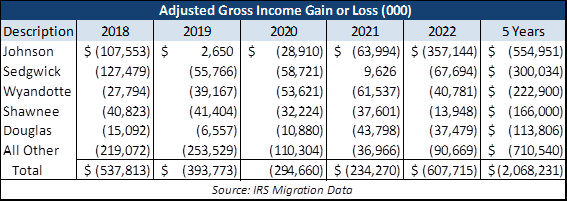High Tax-State Exodus: Kansas Feels the Impact
Recent Internal Revenue Service (IRS) data underscore a significant trend: people and income continue moving from high-tax to low-tax states. The pandemic lockdowns accelerated this movement, and even as life returns to a semblance of normalcy, the exodus continues unabated as policies matter.
The IRS reports migration data between states reveal that in 2022, California topped the list of net losers in adjusted gross income (AGI), shedding $23.8 billion. Other high-tax, blue states, New York, Illinois, New Jersey, and Massachusetts, were the biggest losers, collectively losing billions in AGI. Conversely, low-tax, red states like Florida, Texas, South Carolina, Tennessee, and North Carolina emerged as the biggest net gainers, with Florida alone attracting $36 billion in AGI.
According to the Wall Street Journal, the flight from blue, high-tax states far surpasses pre-pandemic levels. California’s income loss in 2022 was nearly three times that of 2019. New Jersey saw a record net income loss, largely due to fewer New Yorkers relocating across the Hudson River. Although lower than during the pandemic, New York’s AGI loss was still about 50% higher in 2022 compared to 2019.
This migration pattern illustrates a clear preference for states with lower taxes, less regulation, and more business-friendly environments. The top income-gaining states share common pro-growth policies that promote economic growth, highlighting the significant impact of state policies on migration decisions as people move with their feet.
Kansas: A State of Concern
For Kansas, the story is one of consistent outmigration. The net loss from domestic migration in 2022 marked the 28th out of the last 30 years, with a staggering loss of over $600 million and more than $2 billion over the last five years. This represents the second-highest loss in three decades, second only to 2017 when the state imposed its highest tax increase. The average state outmigration loss in Kansas, about $76,000 per return, indicates a broad spectrum of incomes are leaving. Moreover, Kansas’ biggest gains came from higher-tax states, and its losses went to lower-tax states.
Johnson County, often hailed as Kansas’s economic engine, accounted for over half of the state’s AGI loss at $357 million in 2022. This marks the fifth out of the last six years that Johnson County has experienced a net loss. Despite having about 20% of the state’s population, it has borne a disproportionate share of the AGI loss, which coincides with efforts to shift the county politically left and impose significant property tax hikes that reduce affordability.
Considering data from the Kansas Policy Institute’s Green Book and the Tax Foundation, it becomes clear that Kansas is not alone in facing these challenges. However, the extent of the problem in Kansas is particularly alarming compared to other states. The IRS data indicate that while many states have rebounded or stabilized post-pandemic, Kansas continues to struggle with significant outmigration.

Economic and Policy Implications for Kansas
The significant outmigration from Kansas has several implications:
- Tax Revenue Decline: The loss of high-income earners means a significant reduction in tax revenues, impacting public services and infrastructure investments.
- Economic Growth Stagnation: The departure of skilled workers slows economic growth and innovation, making it harder for businesses to find qualified employees.
- Increased Tax Burden: As the tax base shrinks, the remaining residents face increased tax burdens to compensate for the lost revenue.
Kansas’s Path to Prosperity
In response to these challenges, Kansas must adopt a comprehensive approach that includes responsible budgeting, tax relief, and the removal of barriers to work and education. Here are some key policy recommendations:
- Responsible Budgeting: Limiting government spending growth to less than the rate of population growth plus inflation is essential to prevent excessive tax burdens and ensure fiscal sustainability. Kansas must implement stricter fiscal rules to control government spending and avoid future tax hikes that drive residents away.
- Eliminating Personal Income Taxes: Quickly phasing out personal income taxes can make Kansas more attractive to residents and businesses, fostering economic growth and increasing competitiveness. States like Florida and Texas, which have no state income tax, have seen significant AGI inflows, highlighting this approach’s economic benefits.
- Removing Barriers to Work: Reforming or eliminating unnecessary occupational licensing can open up opportunities for more Kansans to enter the workforce, boosting employment and economic activity. Simplifying the licensing process and reducing regulatory hurdles can make it easier for individuals to start new careers or businesses.
- School Choice: Expanding school choice through universal education savings accounts can improve educational outcomes and provide families with more opportunities to tailor education to their children’s needs. A more competitive and diverse educational landscape can attract families looking for quality education options, helping to retain and attract residents.
Addressing Migration Trends
The migration trends underscore the importance of adopting free-market, pro-growth policies prioritizing economic freedom and personal responsibility. Kansas can learn from states that have successfully attracted residents and income by implementing policies that reduce the size of government, lower taxes, and eliminate burdensome regulations.
The continued outmigration from Kansas highlights the urgent need for policy reforms that can reverse this trend. By learning from the successes of states that have managed to attract people and income, Kansas can chart a path toward a more prosperous future. Addressing the underlying issues driving residents away is crucial to ensuring the state’s long-term economic stability and growth.





